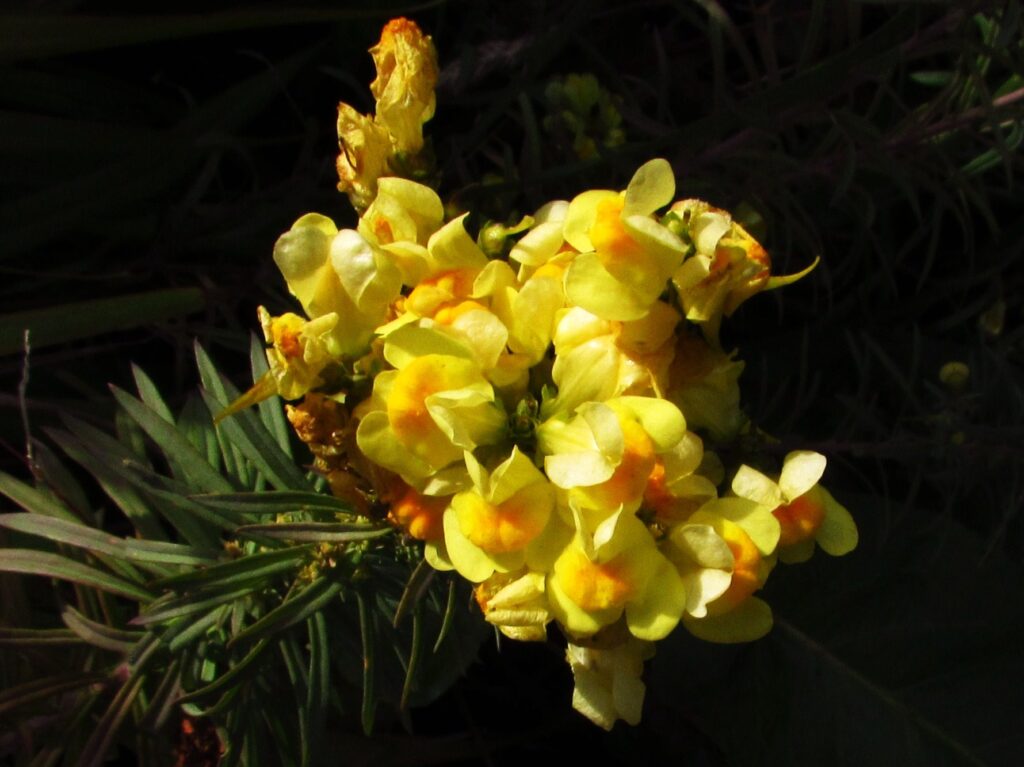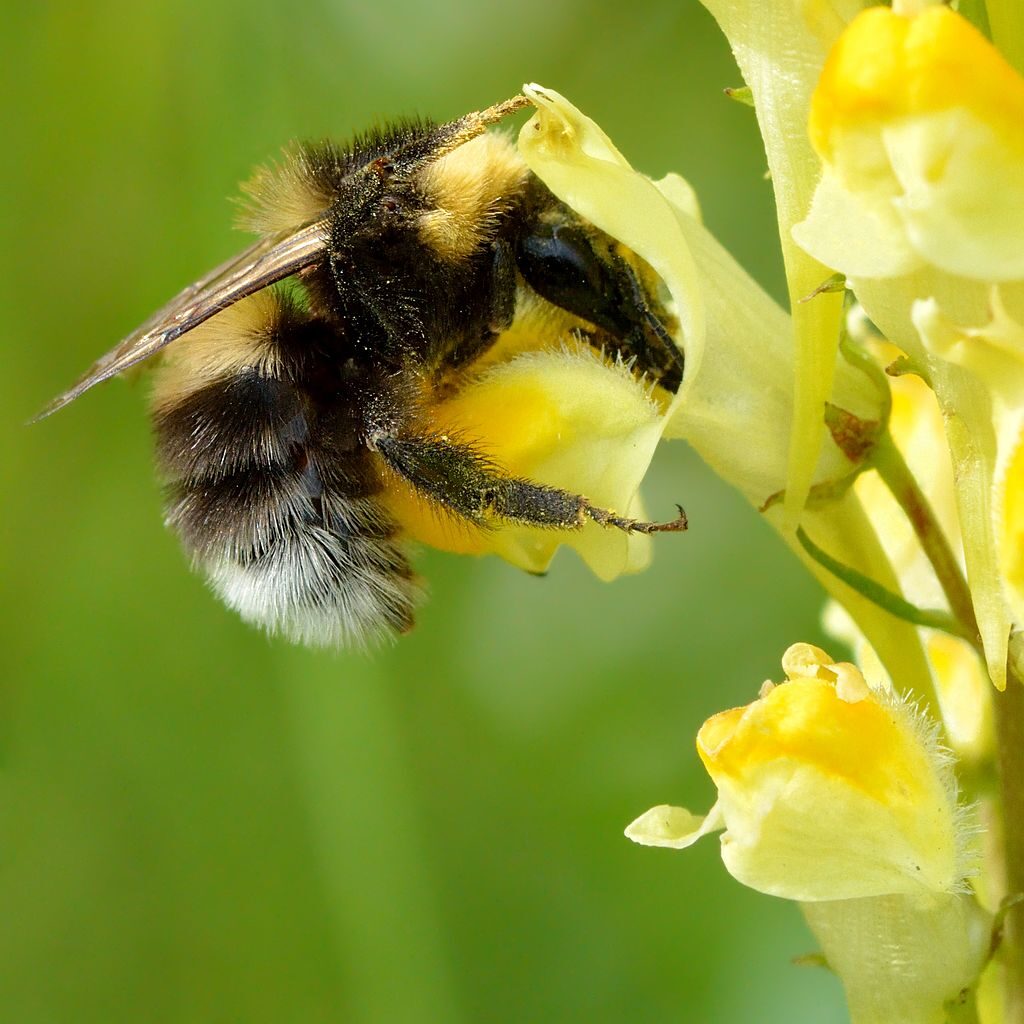I would like to talk about a very attractive plant today called the Common Toadflax or Linaria vulgaris. At the moment (end of August) it is flowering in profusion all along the motorways and other big roads.

The plant is widespread also on ruderal spots, in dunes, and on disturbed and cultivated land.
It used to be in the Scrophulariaceae family and you may well still be finding this in most floras, but this family has been split into five families. More about this later.
In the Netherlands we call this ‘Lion’s Mouth’, which I think is a nicer name for this pretty yellow wild flower! However when I looked in Mrs Grieve’s book, ‘A Modern Herbal’ (page 815) I noticed it is also one of the many other names for Toadflax.
I found the following 16 names: Fluellin, Pattens and Clogs, Flaxweed, Ramated, Snapdragon, Churnstuff, Dragon-bushes, Brideweed, Toad, Yellow Rod, Larkspur Lion’s Mouth, Devils’ Doggies, Calves’ Snout, Eggs and Bacon, Buttered Haycocks and last but not least; Monkey Flower.
The name Toadflax originated in the resemblance of the flower to little toads, there being also a resemblance between the mouth of the flower and the wide mouth of the toad. The general resemblance of the plant in early summer to a flax plant, accounts for the latter part of its name.
I use colour coding for easy reading! Blue background is general interesting info (although I hope you find it all interesting!!). Green is about all the uses except for medicinal uses or if there is a warning in which case I use a pink background. Pictures by Matt Summers unless stated.

Wildlife Uses:
Because the flower is largely closed by its underlip, pollination requires strong insects such as bees and bumblebees (Bombus species).
An interesting account of the pollination of the toadflax:
“The mouth of the flower is completely closed and never opens until a bee forces its entrance. The only visitors are the large bees – the bumble bee, honey-bee, and several wild bees – which are able to open the flower, and whose tongues are long enough to reach the nectar, which is so placed in the spur that only long-lipped insects can reach it. The closing of the swollen lower lip excludes beetles from the spur.
When the bee alights on the orange palate, the colour of which is specially designed to attract the desired visitor, acting as a honey guide, it falls a little, disclosing the interior of the flower, which forms a little cave, on the floor of which are two ridges of orange hairs, a track between them leading straight to the mouth of the long, hollow spur. Above this is the egg-shaped seed vessel with the stamens. Between the bases of the two longer stamen filaments, nectar trickles down along a groove in the spur, from the base of the ovary where it is secreted. The bee pushes into the flower, its head fitting well into the cavity below the seed-vessel and thrusting its proboscis down the spur, sucks the nectar, its back being meanwhile well coated by the pollen from the stamens, which run along the roof, the stigma being between the short and long stamens.
It is reckoned that a humble bee can easily take the nectar from ten flowers in a minute, each time transferring pollen from a previous flower to the stigma of the one visited, and thus effecting cross-fertilization.”
The plant is food plant for a large number of insects such as:
the sweet gale moth (Acronicta euphorbiae), mouse moth (Amphipyra tragopoginis), silver Y (Autographa gamma), Calophasia lunula, gorgone checkerspot (Charidryas gorgone carlota), toadflax pug (Eupithecia linariata), satyr pug (Eupithecia satyrata), Falseuncaria ruficiliana, bog fritillary (Boloria eunomia), Pyrrhia umbra, brown rustic (Rusina ferruginea), and Stenoptilia bipunctidactyla.
It may be mildly toxic to livestock.
Medicinal Uses:
It had several medicinal uses in the past but not very much in the present day, Mrs Grieve mentions it to be Astringent, Hepatic and Detergent.
- The fresh plant is sometimes applied as a poultice or fomentation to haemorrhoids, and an ointment of the flowers has been employed for the same purpose, and also locally in diseases of the skin. A cooling ointment is made from the fresh plant – the whole herb is chopped and boiled in lard till crisp, then strained. The result is a fine green ointment, a good application for piles, sores, ulcers and skin eruptions.”
- The juice of the herb, or the distilled water, has been considered a good remedy for inflammation of the eyes, and for cleansing ulcerous sores.
Other Uses:
- Boiled in milk, the plant is said to yield an excellent fly poison, and it is an old country custom in parts of Sweden to infuse Toadflax flowers in milk, and stand the infusion about where flies are troublesome.
- The flowers have been employed in Germany as a yellow dye.
- I recently read in the RHS magazine ‘The Garden’, Sept. 2018 (on the news page 8) that it is one of the most visited flower by bees. Information was collected via a mobile phone app launched last summer by the RHS and has found that gardeners and allotment holders could make their plots more inviting to pollinators by planting Viper’s Bugloss (Echium vulgare, Teasel (Dipsacus fullonum) and Toadflax (Linaria vulgaris), as these had the most bee-visits. See here:
This is what Stace has to say about the recent classification issues with Scrophulariaceae:
“The circumscription of the Scrophulariaceae has changed more than that of any other family as a result of molecular investigation, our representatives being now placed in four additional families (Paulowniaceae, Phrymaceae, Calceolariaceae and Veronicaceae), as well as the removal of the semi-parasitic Pediculariaceae to the Orobanchaceae. In addition the Buddlejaceae are now amalgamated with the Scrophulariaceae sensu stricto.”
The Toadflax is now in the Veronicaceae and is 1 of the 2 main families created by the fragmentation of the Scrophulariaceae following molecular evidence. The Toadflaxes (tribe Antirrhinea – genera 5-11) are easily recognised by their 2-lipped corolla with boss-like swelling on lower lip and conspicuous spur or pouch at base of tube; the others (genera 1-4 in Veroniceae (Digitaleae) are distinguished from other former Scrophulariaceae as a unit only by complex combination of characters, but all 4 genera are individually very distinctive.”
More about these other genera in a future blog!
